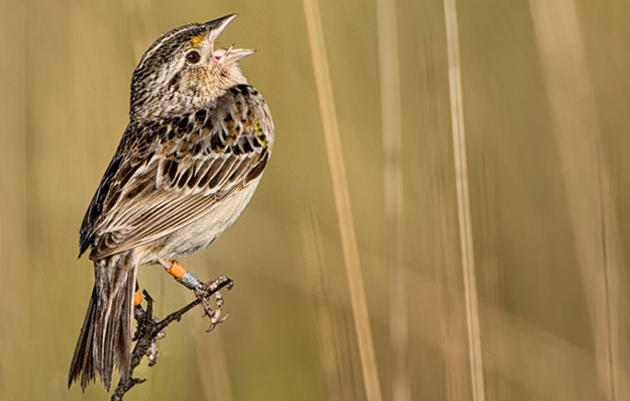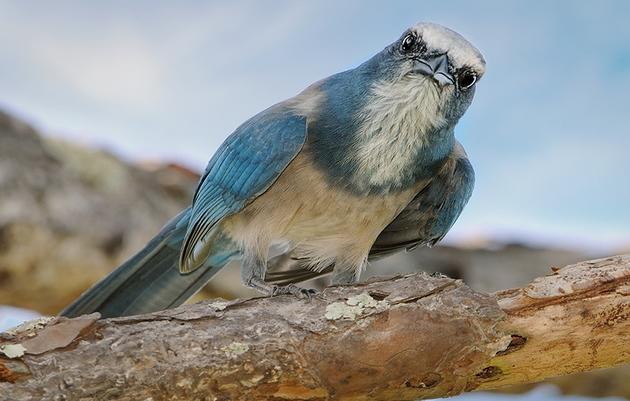Florida is home to many species of imperiled birds. Most are considered imperiled because their habitat has been fragmented or eliminated by human development and agriculture. The remaining habitat, in many cases, is affected by human disturbance. Whether resting on a mangrove island or nesting on a barrier island beach, these birds need their space, which is increasingly difficult to find. Audubon Florida legislative and policy staff are developing and pushing conservation land acquisition, management, and protection strategies within the state while biologists and bird stewards help educate the public and monitor nesting activity at colonies on tree islands, on rooftops, and along Florida’s shores.
For a complete listing of Florida's imperiled birds, visit MyFWC.com.
American Oystercatcher (Haematopus palliatus) -- State Threatened
The American Oystercatcher is one of the largest and most striking birds seen along Florida’s shores, with brown and white plumage, pink legs, thick orange bill, and yellow eyes with bright orange eye-ring. Florida’s year-round population of approximately four hundred nesting pairs of oystercatchers is augmented by an influx of more than 1,500 migratory birds each winter. They mostly eat mollusks and frequent coastal areas where oysters are abundant. Resident birds nest on sandy beaches and rooftops and are highly vulnerable to disturbance. Learn how Audubon’s coastal bird stewardship program is helping give these birds a fighting chance.
Bald Eagle (Haliaeetus leucocephalus)
The Bald Eagle is an American success story. Thanks to conservation efforts over the past several decades, the Bald Eagle is no longer listed under the U.S. Endangered Species Act but remains protected by both the state eagle rule and federal law. Florida has a robust nesting population, with an estimated 1,500 nesting pairs. Most eagle nests are in live native pine trees but the birds also nest in cypress trees, oaks, mangroves, and artificial structures such as communication towers. You can help eagles by joining Audubon’s EagleWatch, which engages volunteers and individuals in protecting our nation's symbol.
Black Skimmer (Rynchops niger) –- State Threatened
Black Skimmers look like masked bandits with short legs, black and white plumage and a black and orange bill. The lower half of their bill is longer than the upper, enabling them to “skim” across the water with their mouth partly open and bill dragging across the surface in search of a fish. Because they nest in colonies on the sand just above the high-tide line, they are very susceptible to loss of eggs and young from storms, high tides and human disturbance. Learn how Audubon’s coastal bird stewardship program is helping give these birds a fighting chance.
Brown Pelican (Pelecanus occidentalis)
Brown Pelicans are seabirds that can live in fresh or saltwater environments. They are brown and white with short legs and are easily recognized by their long, narrow bill that is hooked at the end: the large pouch is their most obvious feature. They specialize in eating fish, which they catch by plunge-diving. In the 1960s, Brown Pelicans, along with several other species of fish-eating birds, were nearly wiped out by impacts from the pesticide DDT. No longer listed in Florida as of 2017, they remain part of the Imperiled Species Management Plan as they continue to face dire threats from loss of wetlands, pollution, nest-site disturbance, and entanglement in fishing line. Learn about Audubon’s ColonyWatch program.
Florida Grasshopper Sparrow (Ammodramus savannarum floridanus) – Federally Endangered
The Florida Grasshopper Sparrow is a federally endangered bird found nowhere else in the world. These sparrows inhabit dry open prairies in south central Florida where they feed on seeds and grasshoppers. The conversion of open prairie habitat to agricultural fields and pasture land has caused destruction of native habitats for the grasshopper sparrow. Despite public land managers’ efforts to recover the bird, its population continues to decline steeply on the very lands where it should be thriving. To date, captive breeding has been successful and grasshopper sparrows are being released back into the wild on public lands. Without continued funding for captive breeding and reintroduction programs, the outlook is dire for this diminutive Florida prairie specialist. Learn more about the Florida Grasshopper Sparrow.
Florida Scrub-Jay (Aphelocoma coerulescens) -- Federally Threatened
The Florida Scrub-Jay is endemic to Florida, meaning it is only found in the sunshine state. Scrub-jays live only in a specific habitat known as Florida scrub. Scrub is typically found at Florida’s highest elevations, where the soils are sandy and well-drained, just inland parallel to Florida’s coasts as well as in the interior of the Florida peninsula. Much of Florida’s scrub habitat was converted to citrus groves and other agricultural uses or developed for residential and commercial use. Habitat fragmentation and fire suppression are two of this jay’s greatest threats; without fire, open sandy patches in which the jays cache their winter food supply of acorns succeed into shady forests that no longer serve the Scrub-jay’s needs. Learn about Audubon Florida’s Jay Watch program.
Least Tern (Sternula antillarum) –- State Threatened
Each spring, Least Terns migrate from Central and South America to Florida’s shores and beyond for summer nesting season. They nest in large groups called colonies. While most natural predators can be deterred by the colony’s mobbing behavior, these birds are highly vulnerable to disturbance by humans and pets, and have absolutely no defense against toxic algae or rising seas. Because many of Florida’s beaches have been altered by development or are crowded with beach visitors, their only choice is sometimes a flat, gravel-covered rooftop, which can pose a unique set of dangers to small chicks that can fall off unprotected roof edges. Learn how Audubon’s coastal bird stewardship program is helping give Least Terns and other chicks a fighting chance.
Little Blue Heron (Egretta caerulea) –- State Threatened
Little Blue Herons are found across Florida nesting at freshwater sites as well as on coastal islands. Although they nest in colonies with other herons and egrets, they forage alone, primarily in freshwater habitats. They eat fish, shrimp, amphibians, and insects, and are vulnerable to the continuing alteration of wetlands caused by development. Learn about wading bird monitoring at Audubon’s Coastal Islands Sanctuaries, established in 1934 to protect the colonial waterbirds along the west central coast of Florida.
Reddish Egret (Egretta rufescens) –- State Threatened
This species is the rarest heron in North America, with the five Gulf Coast states comprising the northernmost part of its range. Eliminated from Florida by the plume-hunters by the late 1800s, Reddish Egrets returned naturally to former breeding sites by 1974. Since then, the number of nesting pairs has slowly climbed to 480 across the state, as published recently in the Florida Field Naturalist (Cox et al, 2019). Reddish Egrets have a blue-gray body with mauve-colored head and chest, but white morph birds are also seen, primarily in the Tampa Bay region. These birds nest with other wading birds in coastal island colonies. Learn about Audubon’s ColonyWatch program.
Roseate Spoonbill (Platalea ajaja) –- State Threatened
Roseate Spoonbills are among the most stunning and recognizable birds along Florida’s shores -- their bright pink plumage with deep pink wing accents, orange tail feathers, and spoon-shaped bills make them easy to identify. The spoonbill’s plumage was highly prized by plume hunters and the species was largely extirpated in Florida by 1900. While their numbers have rebounded significantly, they are still at risk due to loss of habitat and erratic water levels in Florida Bay affecting food availability. To learn about their reproductive success and habitat use, scientists are banding these birds at nest sites around the state - if you see a banded spoonbill, report it here!
Snail Kite (Rostrhamus sociabilis plumbeus) –- Federally Endangered
Snail Kites are uniquely adapted to eating their namesake food: apple snails. The success of the endangered Everglade Snail Kite is a key ecological indicator for the health of the Greater Everglades. Snail Kite numbers declined significantly until the early 2000s due to degradation of water quality and sporadic water levels that were wreaking havoc on wetland plants and the kites’ namesake food item. Their numbers have since rebounded, but they are still in danger of extinction. Learn how Audubon is helping Everglade Snail Kites.
Snowy Plover (Charadrius nivosus) –- State Threatened
Snowy Plovers are year-round Florida residents that nest on white sand beaches, near passes, and along intertidal sand flats. They pluck small invertebrate animals from the breaking surf and forage for insects along the upper beach. Once common along Florida’s Gulf coast, Snowy Plover numbers are steadily declining primarily due to disturbance, predation, and loss of habitat. High rises and other development along our coast prevent beaches from retreating in response to sea level rise, potentially leaving these solitary ground-nesters nowhere to go. Learn how Audubon’s coastal bird stewardship program is helping give these chicks a fighting chance.
Tricolored Heron (Egretta tricolor) –- State Threatened
Tricolored Herons are widely distributed across Florida, feeding primarily on fish from fresh and saltwater habitats. They are slate gray with a reddish-blue head and neck, and a white belly and throat. These birds are among the smaller waders in Florida. They nest colonially in freshwater and coastal island colonies, where they often compete with larger species for the best nest spots. Learn about Audubon’s ColonyWatch program.
Wilson's Plover Charadrius wilsonia
Wilson’s Plovers are slightly more common than the Snowy Plover and more flexible in their habitat requirements. However, monitoring data indicate both a declining population and a contracting range. These plovers are solitary ground nesters that feed primarily on fiddler crabs and other coastal invertebrates. Development and disturbance to nesting areas from beach-recreation and management are significant causes of population decline. They are particularly susceptible to rising sea levels. Learn how Audubon’s coastal bird stewardship program is helping give these chicks a fighting chance.
Wood Stork Mycteria americana –- Federally Threatened
Wood Storks are year-round Florida residents that nest colonially over water, historically in mangroves or cypress trees. In recent decades, records they have also been found nesting in altered habitats on islands in man-made stormwater ponds, using Brazilian pepper and other trees. Their feeding strategy relies completely on shallow water levels where they can wade. These tactile feeders sweep their heads back and forth through the water with bill open until they make contact with a fish, frog, crayfish or other aquatic animals. During the nesting season, adults rely on the seasonal dry-down of wetland areas to concentrate prey, allowing efficient foraging to provide for their rapidly growing chicks. Learn how Audubon is helping protect Wood Storks.
Imperiled Florida Birds
Focus Species
Florida Grasshopper Sparrow
The Florida Grasshopper Sparrow is a federally endangered bird found nowhere else in the world.
Everglade Snail Kite
The Everglade Snail Kite is a bird of prey with a very particular appetite: it feeds almost exclusively on apple snails.
Wood Stork
The Wood Stork is one of Florida’s signature wading birds, a long-legged, awkward-looking bird on land that soars like a raptor in the air.
How you can help, right now
Donate to Audubon
Help secure the future for birds at risk from climate change, habitat loss and other threats. Your support will power our science, education, advocacy and on-the-ground conservation efforts.
Become a Monthly Donor
Donating monthly is flexible, easy and convenient and makes you a champion birds can count on, no matter the season.
Volunteers Needed
Florida's birds and wildlife need your time and energy. Learn how you can become a citizen scientist or a volunteer at one of our nature centers today.






















